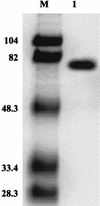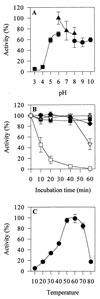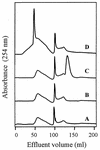Purification and characterization of laccase from Chaetomium thermophilium and its role in humification
- PMID: 9726856
- PMCID: PMC106706
- DOI: 10.1128/AEM.64.9.3175-3179.1998
Purification and characterization of laccase from Chaetomium thermophilium and its role in humification
Abstract
Chaetomium thermophilium was isolated from composting municipal solid waste during the thermophilic stage of the process. C. thermophilium, a cellulolytic fungus, exhibited laccase activity when it was grown at 45 degreesC both in solid media and in liquid media. Laccase activity reached a peak after 24 h in liquid shake culture. Laccase was purified by ultrafiltration, anion-exchange chromatography, and affinity chromatography. The purified enzyme was identified as a glycoprotein with a molecular mass of 77 kDa and an isoelectric point of 5.1. The laccase was stable for 1 h at 70 degreesC and had half-lives of 24 and 12 h at 40 and 50 degreesC, respectively. The enzyme was stable at pH 5 to 10, and the optimum pH for enzyme activity was 6. The purified laccase efficiently catalyzed a wide range of phenolic substrates but not tyrosine. The highest levels of affinity were the levels of affinity to syringaldazine and hydroxyquinone. The UV-visible light spectrum of the purified laccase had a peak at 604 nm (i.e., Cu type I), and the activity was strongly inhibited by Cu-chelating agents. When the hydrophobic acid fraction (the humic fraction of the water-soluble organic matter obtained from municipal solid waste compost) was added to a reaction assay mixture containing laccase and guaiacol, polymerization took place and a soluble polymer was formed. C. thermophilium laccase, which is produced during the thermophilic stage of composting, can remain active for a long period of time at high temperatures and alkaline pH values, and we suggest that this enzyme is involved in the humification process during composting.
Figures



References
-
- Adani F, Genevini P L, Tambone F. A new index of organic matter stability. Compost Sci Utiliz. 1995;3:25–37.
-
- Bavendamm W. Uber das Vorkommen und den Nachweis von Oxydasen bei holzzerstoerenden Pilzen. Z Pflanzenkr Pflanzenschutz. 1928;38:257–276.
-
- Bollag J M, Liu S Y, Minard R D. Enzymatic oligomerization of vanillic acid. Soil Biol Biochem. 1982;14:157–163.
Publication types
MeSH terms
Substances
LinkOut - more resources
Full Text Sources
Other Literature Sources

